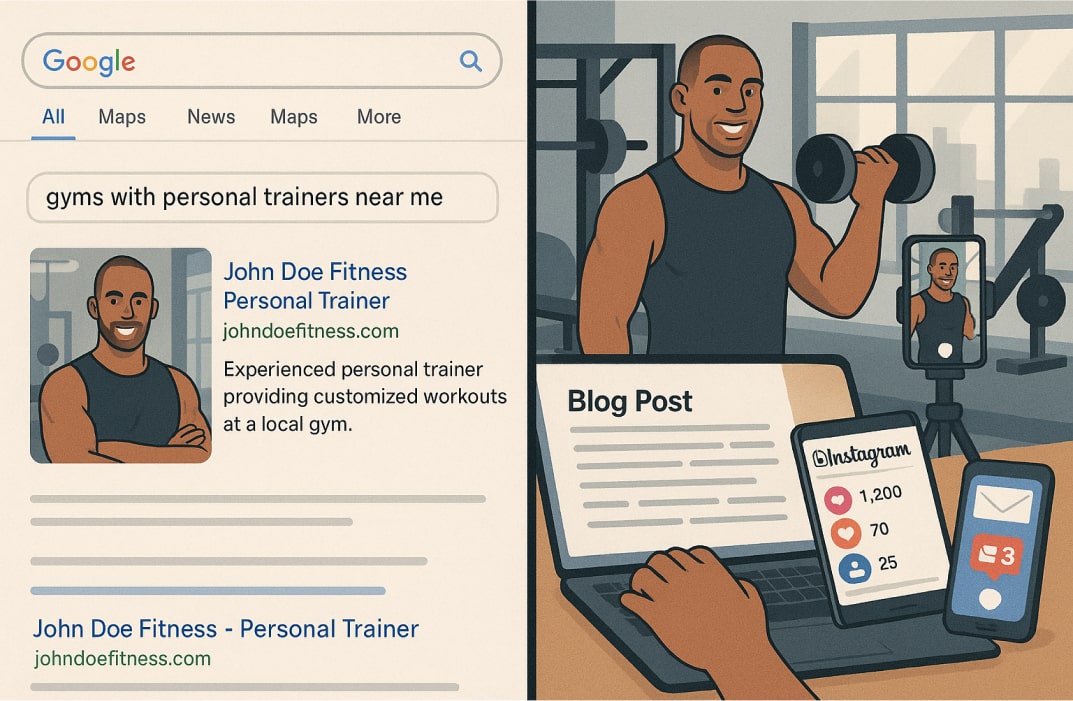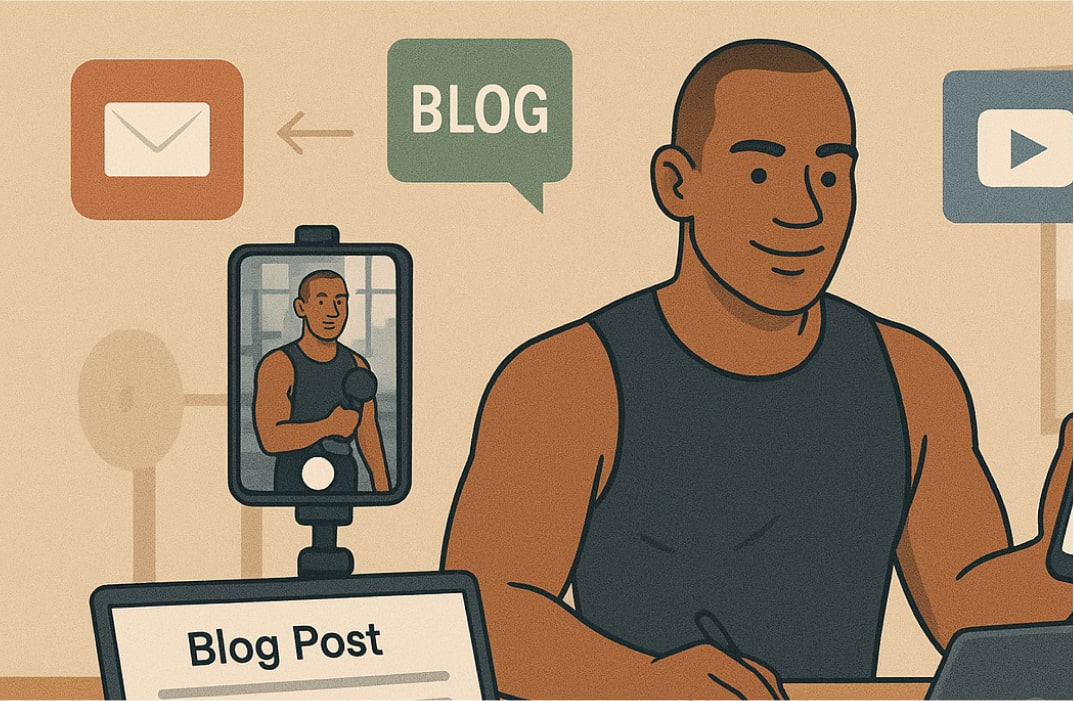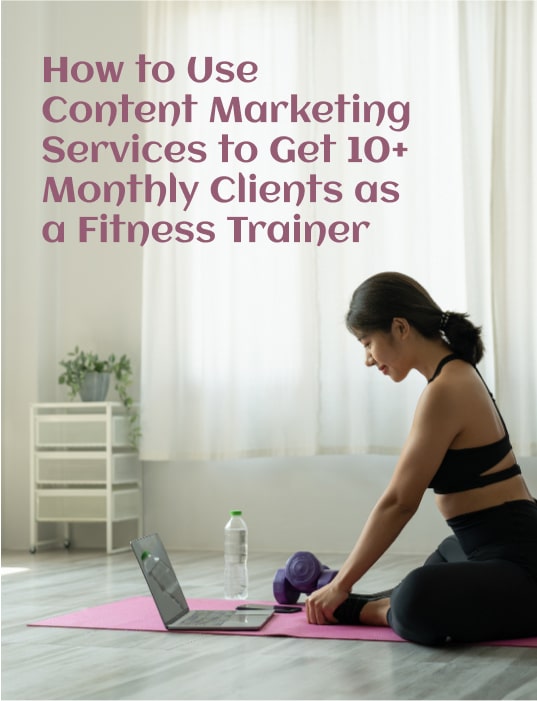In today's digital-first world, personal trainers are no longer just competing on the gym floor—they're competing on Google, YouTube, and Instagram. The best personal trainers aren't always the most qualified—they're the most visible. That's where content marketing becomes your biggest asset.
If you're a fitness professional looking to consistently gain 10+ new clients monthly, it's time to harness the power of strategic content marketing. In this masterclass, you'll learn how to use content marketing services, SEO, social media, and video to build your brand, generate leads, and convert online followers into paying clients.
Why Content Marketing Is Critical for Fitness Trainers
The fitness industry is crowded with both gyms and independent personal trainers. Whether people search for "gyms with personal trainers near me" or ask "how much are personal trainers", they're researching online first—often comparing websites, reading blog posts, and checking social media profiles before making a decision.

So, how do you stand out?
You need a content marketing strategy that:
- Drives organic traffic from search engines
- Builds brand recognition and authority
- Educates and nurtures potential customers
- Generates qualified leads
- Drives engagement on social media and your website
When done right, content marketing positions you as an expert in your niche, whether you specialize in fat loss, strength training, or post-rehab fitness. By sharing valuable, relevant, and consistent content, you build trust long before a potential client books a session. Unlike traditional paid advertising, content marketing efforts yield long-term ROI by consistently attracting your target audience with high-value content across various channels, including blogs, videos, email, and social platforms. It's not just about visibility—it's about establishing yourself as the go-to authority in your fitness space.
What Is Content Marketing for Personal Trainers?
Content marketing is the process of creating and distributing high-quality content to attract and retain customers. For personal trainers, this might include:

- Blog posts
Share in-depth educational content, such as "Top 5 Workouts for Fat Loss" or "Strength Training for Beginners," to address common fitness questions. These posts improve your search visibility and position you as a credible expert. - YouTube videos or reels
Create visual content, such as "What I Eat in a Day," proper form tutorials, or workout routines. These videos not only engage your audience but also help build trust and showcase your personality and coaching style. - Social media content
Post client transformations, quick fitness tips, motivational quotes, and behind-the-scenes content to increase engagement and build a community. Short-form videos and carousel posts can drive interaction and boost your reach. - Email newsletters
Utilize email to maintain connections with leads and clients. Share training updates, special offers, fitness advice, or motivational content. Regular emails keep you top-of-mind and nurture relationships over time. - Free downloads
Offer value-packed lead magnets, such as meal plans, workout calendars, habit trackers, or fitness challenges, to attract and engage potential customers. These resources help build your email list and provide a strong entry point into your service funnel.
This content creation should always be designed to guide potential clients through the buyer's journey—from awareness, to interest, to action. Compelling content helps people identify their pain points, see you as the solution, and take the next step toward booking a session or consultation. Over time, it builds trust, authority, and a loyal community around your brand.
Step-by-Step Content Marketing Strategy to Gain 10+ Clients a Month
Let's break down the core components of an effective content marketing campaign for fitness professionals.
Step 1: Define Your Business Goals and Target Audience
Before you post anything, you need clarity on:
- Who are you helping
Identify your ideal client—such as busy moms, athletes, or beginners—so your content speaks directly to their needs. - What transformation do you offer?
Clarify whether you're helping with fat loss, building strength, improving mobility, or recovering from an injury. Your message should align with that outcome. - Where do you deliver your services?
Online, in-person, or hybrid? This determines how and where you distribute content.
Your business goals must guide your content strategy. If you want 10+ new clients each month, your content should:
- Educate your audience
Share practical tips and insights to build trust. - Address pain points
Speak to real struggles—like motivation, time, or confusion—and provide solutions. - Showcase your expertise
Use testimonials and results to demonstrate the effectiveness of your methods. - Include clear CTAs
Tell people exactly what to do next—book a call, download a guide, or sign up.
Step 2: Optimize for SEO and Organic Search
SEO and content marketing go hand-in-hand. Without SEO, even your best content won't be seen.
A content marketing agency or technical SEO service can support you with:
- Keyword research
Identify high-intent search terms, such as "best personal trainers near me" or "how much do personal trainers cost," to target the right audience. - Content optimization
Ensure your blog posts, videos, and landing pages are structured for visibility and performance. - Website performance
A mobile-friendly, fast-loading site boosts both user experience and rankings.
If you're working with local clients, focus on local SEO by setting up and optimizing your Google Business Profile to show up in local search results and maps.
Step 3: Create a Consistent Content Calendar
Consistency builds trust and visibility. Plan a weekly or bi-weekly schedule to keep your audience engaged and your brand at the forefront of their minds.
Include content like:
- SEO-rich blog posts to educate and rank in search
- Social media posts such as reels, stories, or tips
- Email newsletters to nurture leads
- Branded or influencer collaborations to expand reach
Use a variety of formats to keep things fresh:
- Blogs and infographics
- Reels or TikTok
- Long-form YouTube videos
- Instagram carousels
A consistent calendar ensures you're always showing up—and staying relevant. It also helps you batch and repurpose content more efficiently, saving time while maintaining quality. Over time, consistency positions you as a reliable expert that clients can trust.
Step 4: Use Video Content Marketing to Build Trust
Video content marketing is one of the fastest and most effective ways to build rapport. It allows potential clients to experience your style, personality, and expertise before ever booking a session, helping to establish trust early.
Content ideas include:
- Client transformations that showcase real results
- How-to workout tutorials that demonstrate your knowledge
- Q&A sessions answering common fitness questions
- Day-in-the-life vlogs to show authenticity and relatability
- Nutrition tips to add extra value beyond workouts
Use video across multiple platforms—Instagram Reels, YouTube Shorts, TikTok, and your website—to boost visibility and generate leads. Videos also improve time-on-page and engagement, signaling credibility to both users and search engines. Even short, consistent clips can significantly increase conversions and brand loyalty over time.
Step 5: Repurpose Content for Maximum Impact
Creating content doesn't mean starting from scratch every time. Repurposing helps you maximize the value of what you've already created, saving time while maintaining consistency.
For example, one blog post can become:
- 3 Instagram captions to spark engagement
- 2 short-form videos to share key takeaways visually
- 1 infographic to simplify and visualize complex info
- 1 email newsletter to nurture your list with valuable insights
This is a cost-effective way to extend your content across multiple platforms without overexertion. It also reinforces your message across different formats, helping it stick more effectively. Content marketers and content marketing services can help create repurposing workflows, allowing you to stay visible without constantly producing new content.
Step 6: Leverage Email Marketing and Lead Magnets
Attracting traffic is just the beginning—you also need to capture and convert that interest into sales. Offer a compelling lead magnet in exchange for an email address to start building a relationship.
Examples include:
- Free meal plan tailored to common goals like fat loss or muscle gain
- "Beginner's Workout Guide" to help new clients get started with confidence
- 5-day fitness challenge that delivers quick wins and builds momentum
Once you've captured leads, use email marketing services to nurture them with weekly tips, success stories, fitness advice, and special offers. Email allows for personalized communication and is one of the most effective channels for driving conversions. Over time, a well-nurtured list can become your most reliable source of new clients and referrals.
Step 7: Track Performance and Optimize
Creating content is only half the equation—measuring its performance is what turns good content into great results. Use analytics to track key metrics such as:
- Blog traffic to see what topics attract the most visitors
- Email open rates to understand what subject lines and content resonate
- Social media engagement to gauge audience interest and interaction
- Video watch times to assess how engaging and valuable your videos are
- New leads or bookings to measure real business impact
A skilled content marketing manager or full-service agency will help analyze this data and optimize your strategy accordingly, refining what works and adjusting what doesn't. Regular performance reviews ensure your content continues to support your business goals, drive growth, and deliver real ROI over time.
How Does SEO and Content Marketing Work Together?
When combined, SEO and content marketing act like a magnet. Content attracts traffic, while SEO ensures that the traffic is qualified and intentional.
Here's how they support each other:
- SEO ensures your great content is indexed by search engines
- Content provides the keywords and value that users are looking for
- Together, they increase organic search visibility and organic traffic
Agencies like Omniscient Digital and Siege Media are recognized for their holistic approach, but even solo trainers can effectively implement these tactics. By optimizing blog posts, video descriptions, and landing pages, you can capture leads from local and niche fitness searches. This synergy helps establish long-term authority in your market while steadily growing your inbound client pipeline.
Do You Need a Content Marketing Agency?
Hiring a content marketing agency can fast-track your success, mainly if you're focused on training clients, not writing blogs.
Many marketing agencies in Miami specialize in content strategies tailored to local and national audiences, helping businesses maintain consistency and relevance without sacrificing internal resources.
The best content marketing agencies for fitness:
- Understand the fitness industry and buyer psychology
- Offer content creation, SEO, email, and video services
- Align strategies with your business growth goals
Whether you're looking for a b2b content marketing agency, a content marketing company, or a local marketing agency, make sure they:
- Understand fitness
- Have proven case studies
- Can deliver valuable insights and clear lines of communication
If you're budget-conscious, consider working with a freelancer or smaller content marketing firm while maintaining strategic oversight.
What About AI Content Generation for Marketing?
AI content generation for marketing tools (like ChatGPT) can help you:
- Generate blog ideas
- Write drafts faster
- Create captions and email sequences
- Do initial keyword research
However, AI is most effective when combined with human strategy. Use AI for efficiency, but make sure your content marketing campaign still reflects your voice, values, and client's brand.
Final Thoughts
Great trainers are made in the gym. Great fitness businesses are built online.
Whether you're promoting your services, working online, or going hybrid, content marketing is the tool that bridges your expertise with the clients who need it most.
Don't just post random workout videos—build a brand. Create a strategy. Align your content with your business goals, leverage digital marketing, and consider working with a content marketing service to scale up.
With the right marketing strategy, high-quality content, and dedication to your craft, gaining 10+ clients per month isn't a goal—it's your new normal.
FAQs
1. How to Market a Personal Trainer?
To market yourself as a personal trainer, build a strong online presence through content marketing, social media, and a professional website. Share client results, post workout tips, and create valuable content, such as blogs or videos, to engage your audience. Utilize local SEO to appear in "personal trainer near me" searches and offer complimentary consultations or lead magnets to attract new clients. Collaborations, referrals, and testimonials also boost credibility and visibility.
2. What are the 7 Ps of marketing for a gym?
The 7 Ps of marketing for a gym include:
- Product – Your gym services, personal training, classes, etc.
- Price – Membership fees, session packages, discounts
- Place – Gym location and online access options
- Promotion – Marketing tactics (ads, social media, content marketing)
- People – Trainers, staff, and customer service
- Process – How services are delivered and managed
- Physical Evidence – Clean facilities, branded content, online reviews, and transformation results
3. How to Attract Clients for Fitness Training?
To get fitness clients, start by identifying your niche and ideal audience. Use platforms like Instagram, Facebook, and YouTube to share content that educates and inspires. Optimize your website for local SEO, create a Google Business Profile, and encourage clients to leave reviews. Offer free resources (like a 7-day workout plan) to grow your email list, and use referrals and testimonials to build trust. Paid ads can help scale, but organic content marketing efforts are cost-effective and long-term.
4. How to Attract Clients for Content Marketing?
To get content marketing clients, position yourself as an expert through thought leadership content—blogs, LinkedIn posts, case studies, or a portfolio site. Utilize SEO and social proof to attract inbound leads, and target small businesses or personal brands that lack robust content. Offer free audits or strategy sessions to show value upfront. Joining marketing groups, using freelance platforms, or collaborating with a content marketing agency can also help build your client base.







